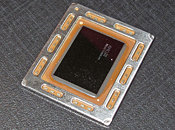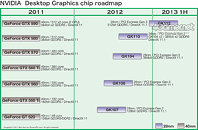
AMD Demonstrates Trinity APU, Its Own Thunderbolt-Alternative
AMD's next-generation accelerated processing unit (APU), codenamed "Trinity", was demonstrated at CES. Trinity will make up AMD's 2012 A-Series APU lineup, and will be designed for mainstream-thru-performance notebooks, and mainstream desktops (different standards for different form-factors). Pictured below is what its notebook-specific BGA package looks like. The package has an exposed rectangular die, with a stabilizer frame around it (like with GPUs). Notebooks' cooling assembly heat pipes make direct contact with the die. Trinity packs two Piledriver modules (an evolution of Bulldozer), and DirectX 11.1 AMD Radeon HD 7000M graphics (notebook APU) or HD 7000D (desktop APU).
Shown to the CES crowd was a mind-boggling demo. The public were first shown what appeared to be an ATX desktop connected to two monitors, one monitor running a DIRT 3 DirectX 11 game demo at high-quality settings, and another screeen revealing the APU to be running GPU-accelerated video transcoding. No discrete graphics was used, it's just the embedded HD 7000 at play/work. If that alone didn't raise a few eyebrows, the AMD representative removed the lid of the ATX desktop case to which those two monitors were connected, to reveal a 14-inch laptop inside doing all the work. And there's more - the laptop's main screen wasn't idle, it was running a high-definition video playback. Whatever synthetic benchmarks end up telling about Trinity, its real world performance does impress!You have got to watch the video after the break!
Shown to the CES crowd was a mind-boggling demo. The public were first shown what appeared to be an ATX desktop connected to two monitors, one monitor running a DIRT 3 DirectX 11 game demo at high-quality settings, and another screeen revealing the APU to be running GPU-accelerated video transcoding. No discrete graphics was used, it's just the embedded HD 7000 at play/work. If that alone didn't raise a few eyebrows, the AMD representative removed the lid of the ATX desktop case to which those two monitors were connected, to reveal a 14-inch laptop inside doing all the work. And there's more - the laptop's main screen wasn't idle, it was running a high-definition video playback. Whatever synthetic benchmarks end up telling about Trinity, its real world performance does impress!You have got to watch the video after the break!







